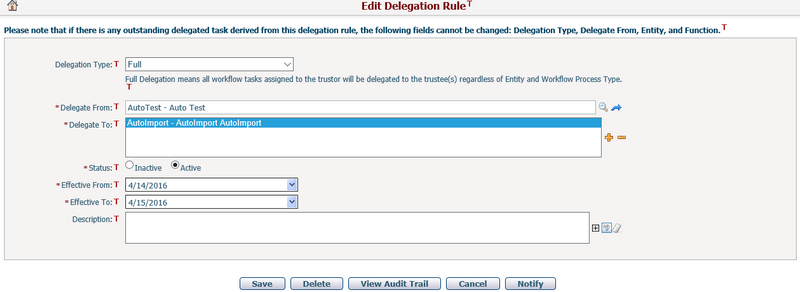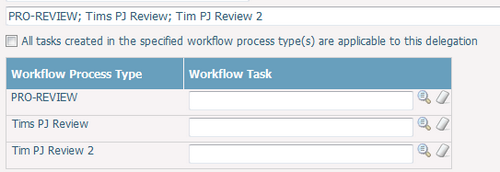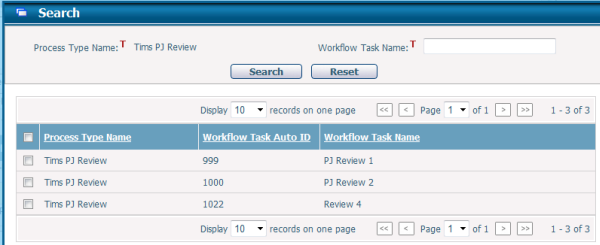Nagivate Here: Utilities > Browse Delegations > Click on Edit icon of a Delegation Rule
From the Edit Delegation Rule page, you can change and update information of a delegation rule.

If there are no outstanding delegated tasks derived from the current delegation rule, all information of the delegation rule can be modified. Otherwise, Delegation Type, Delegate From, Entity and Function fields of the delegation rule will be grayed out and cannot be changed.
Delegated From: specifies the trustor of the delegation. Click on the Lookup icon ![]() to select the trustor of the delegation. There can be only one trustor per delegation.
to select the trustor of the delegation. There can be only one trustor per delegation.
Delegated To: specifies the trustee(s) of the delegation. Click on the Add icon![]() to add active users as trustees to the delegation. To remove a trustee from the delegation, select a trustee and click on the Remove icon
to add active users as trustees to the delegation. To remove a trustee from the delegation, select a trustee and click on the Remove icon![]() .
.
Delegation Type: click on the dropdown list to select the delegation type. There are two types of delegation, Full Delegation and Partial Delegation.
Full Delegation
Under Full Delegation, All workflow tasks of the trustor will be delegated to the corresponding trustee(s) regardless of the entity and workflow process involved. When processing a delegated task, trustee(s) will inherit the trustor’s access rights in relation to the delegated task.
Partial Delegation
Under Partial Delegation, only workflow tasks that match criteria specified by Entity and Workflow Process Type will be delegated to the trustee(s). Access rights granted to the trustee(s) will be specified by Functions.
If Partial (Delegation) is selected, three more fields will appear on the page:
Entity: specifies the data entity related to the delegation. Click on the Lookup icon![]() to bring up a list of available entities. Each Partial Delegation can only be associated with one data entity.
to bring up a list of available entities. Each Partial Delegation can only be associated with one data entity.
Workflow Process Type: specifies the workflow process types applicable to the delegation. Click on the Lookup icon![]() to bring up a list of active workflow process types. Select the desired workflow process types or leave this textbox blank (the default setting) if the delegation applies to all workflow process types of the data entity. Please note, new workflow process type(s) created as a result of modifying participants of an existing workflow process type (from the workflow section of the entity under review) will not be delegated automatically even existing source workflow process types were already selected for delegation. You must add these workflow process types manually from here.
to bring up a list of active workflow process types. Select the desired workflow process types or leave this textbox blank (the default setting) if the delegation applies to all workflow process types of the data entity. Please note, new workflow process type(s) created as a result of modifying participants of an existing workflow process type (from the workflow section of the entity under review) will not be delegated automatically even existing source workflow process types were already selected for delegation. You must add these workflow process types manually from here.
Functions: specifies the access control of the selected entity granted to the trustee (when processing a delegated task). By default the textbox is left blank and the trustee(s) will inherit all function access control from the trustor. To specify access control, click on the Lookup icon ![]() and a list of functions which the trustor has access to will be displayed in the popped up window. Select the desired functions and click on OK to apply the changes.
and a list of functions which the trustor has access to will be displayed in the popped up window. Select the desired functions and click on OK to apply the changes.
“All tasks created in the specified workflow process type(s) are applicable to this delegation” option
It’s possible for a trustor to be involved in multiple tasks of a workflow process type. This option allows you to specify which workflow tasks of a workflow process type will be delegated to the trustee(s). By default all workflow tasks of a workflow process type will be applicable to the delegation.
To specify workflow tasks, deselect the check box, and you will be presented with a list of workflow process types (that you’ve selected previously) and workflow tasks.

Click on the Lookup icon ![]() of each row to specify the workflow tasks for the corresponding workflow process type.
of each row to specify the workflow tasks for the corresponding workflow process type.

A window consists of the name of the Workflow Process Type, the Workflow Task Auto IDs, and Workflow Task Names will pop up. Please note, only workflow tasks belong to:
•the latest deployment version of the workflow process type
•or the workflow process type of running instances
will be available for selection. Select the desired workflow task(s) and click on the OK button to confirm.
Status: toggle the Active and Inactive radio buttons to specify whether the delegation is active or inactive. If there are still outstanding delegated tasks derived from the delegation, you will be asked to specify the users that will process these tasks. For more details, please refer to the Deactivating a Delegation Rule section below.
Effective From/Effective To: specify the validity period of this delegation. During this period, the delegation shall remain effective long as the delegation status is “Active”. The Effective From date shall not be earlier than the current date, and the Effective To date shall not be earlier than the Effective From date.
Description: the description of the delegation
Removing a Trustee
When trustee(s) are removed from a delegation rule, the system will check if there are outstanding delegated tasks belong to the to-be-removed trustees before the changes can be saved. If outstanding workflow tasks exist, you will be prompted the following options when you press the Update button:

Stay with the Trustee: the same trustee(s) will process the outstanding delegated tasks
Assign to other Trustees: New tasks will become inaccessible to the trustee(s) to be removed but still be accessible to the remaining trustee(s) of the current delegation. The “To-be-processed” tasks of the trustee(s) to be removed will be transferred to other trustee(s) as New tasks. By default, this option is selected.
Deactivating a Delegation Rule
Before a delegation rule becomes inactive, the system will check if there are outstanding delegated tasks derived from the current delegation rule before the changes can be saved. If outstanding delegated tasks exist, you will be prompted the following options when you pressed the Update button:

Stay with the Trustee: the same trustee(s) will process the outstanding delegated tasks
Assign to Trustor: New tasks will become inaccessible to the trustees and be transferred back to the trustor. The To-be-processed tasks will also be transferred back to the trustor as New tasks. By default, this option is selected.
Reassign to other Users: manually assign other user(s) to process the trustee’s existing delegated tasks. Once this option is selected, an additional field will be available for you to specify these users. Click on the Lookup icon![]() and select the desired users from the user list. These users will NOT be granted any special access rights from the delegation rule. Whether they have access to the necessary functions to complete the delegated tasks rely entirely on the existing access control rules.
and select the desired users from the user list. These users will NOT be granted any special access rights from the delegation rule. Whether they have access to the necessary functions to complete the delegated tasks rely entirely on the existing access control rules.
Deleting a Delegation Rule
Before a delegation rule can be deleted, the system will check if there are outstanding delegated tasks derived from the current delegation rule. If outstanding delegated tasks exist, you will be prompted the following options when you pressed the Delete button:

Stay with the Trustee: if you select this option, you will be alerted by the following message: “Failed to delete this delegation rule because there are delegated tasks awaiting actions from the trustee(s) of this delegation rule” and deletion will be canceled. This is because once the delegation rule is removed, the trustee’s access rights cannot be determined.
Assign to Trustor: new tasks will become inaccessible to the trustee and be transferred back to the trustor. To-be-processed tasks will also be transferred back to the trustor as New tasks. By default, this option is selected.
Reassign to other Users: manually assign other user(s) to process the trustee’s existing delegated tasks. Once this option is selected, an additional field will be available for you to specify these users. Click on the Lookup icon![]() and select the desired users from the user list. These users will NOT be granted any special access rights from the delegation rule. Whether they have access to the necessary functions to complete the delegated tasks rely entirely on the existing access control rules.
and select the desired users from the user list. These users will NOT be granted any special access rights from the delegation rule. Whether they have access to the necessary functions to complete the delegated tasks rely entirely on the existing access control rules.
Please note a delegation rule with multiple trustees will generate the same “new” workflow task for each of the trustees involved. However, only one workflow task will be transferred/reassigned as a result of the Assign to Trustor operation or Reassign to other Users operation mentioned above.
Click on the Save button to save changes made to the delegation rule.
Click on the Delete button to remove the delegation rule from the system. Once the delegation rule has been successfully removed, you will be directed to the Browse Delegation Rules page.
Click on the View Audit Trail button to view the audit trail details of the delegation rule. You will be directed to the Browse Audit Trail Details page.
Click on the Cancel button to discard all changes. You will be directed to the Browse Delegations page.
Click on the Notify button to send a notification; you will be directed to Send Notification page.